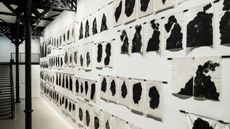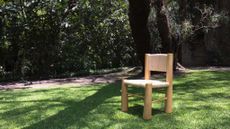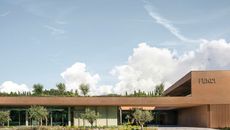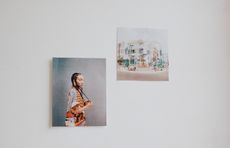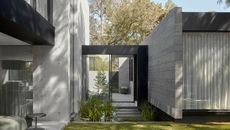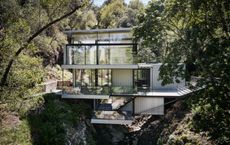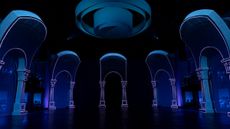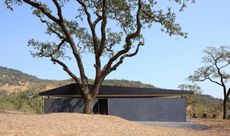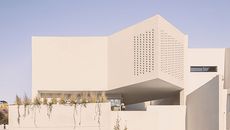Twin 6a architects buildings arrive at London Design District
Two 6a architects-designed buildings, A2 and B2, launch at the Design District in London
- (opens in new tab)
- (opens in new tab)
- (opens in new tab)
- Sign up to our newsletter Newsletter
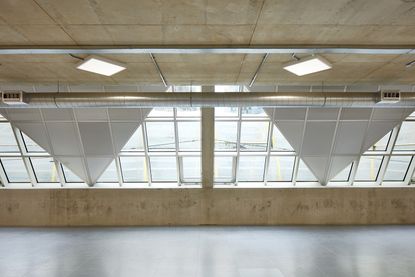
This winter, 6a architects is unveiling not one, but two new buildings in Greenwich Peninsula's Design District. A2 and B2 are now up and running, bringing this quirky, and growing, creative hub in south London one step closer to full completion, while adding some exciting new businesses to the area's curated list of tenants – which so far includes The Photography Foundation and Queercircle.

6a architects' two buildings at the Design District
When 6a architects, the studio led by Stephanie Macdonald and Tom Emerson, was invited to participate at the Design District, the architects jumped at the opportunity to experiment with materials and shapes in this new quarter. The architects drew on the tradition of warehouses and working buildings, ‘in which a few basic qualities of space, light, robustness and repetition provide spaces for all sorts of uses over a very long time'.
The team were also inspired by the idea of designing not one, but two new builds here. 'We were very interested in the “double”, to do the same building twice. Partly because of the industrial nature of the brief and partly as the pair have a long architectural history – Piazza del Popolo in Rome and much closer in the Royal Naval Hospital at Greenwich, by Wren. In our case, the buildings are like non-identical twins; almost the same but not quite – one pale pink, the other green. A couple of minor variations in interior layout but otherwise the same,' they explain.

The result is a set of sharp and geometric structures, close – but not next – to each other. Graphic patterns in the openings and cladding make them stand out, carving their own identity in the Design District's well-known, by now, explosion of colour and shape – its collection so far spans from Roz Barr's minimalist, block-coloured Bureau, to the dichroic surfaces of D2 by Mole Architects.

However, these seemingly random volumes are not an architect's mere flight of fancy. 'The shape was a product of the areas required distributed over the allowable height. We started with a straight extrusion of the footprint repeating up to the maximum height. However, this produced more space than required,' 6a explain. 'So, we started cutting the volume obliquely until we reached exactly the right areas. This cut in turn produced floors with distinctive characters and quite radical proportions, especially the top floor, while allowing more sunlight into the streets and public spaces. The cut also introduced this oblique form which led to exploring it further as a figure for the façade and fenestration.'

The choice of materials was similarly informed by practical needs and qualities, such as durability. The architects ended up using terrazzo and corrugated aluminium on the outside, and blockwork and pink (fireproof) plasterboard (in some places unfinished and exposed, in others green and moisture resistant) inside. The work of American artist Richard Artschwager, who made sculptures using Formica, served as inspiration.

It was a welcome challenge for the architects at 6a: 'It is very rare for a developer to create a centre of creative production like Design District. It is a completely synthetic place, the product of an idea more than evolving over time. In one sense, Design District is quite foreign to London’s general tendency to evolve naturally with uses moving organically around the city over time. On the other hand, it is very like London to be experimentally audacious – to try something new against the current. It has been a great experience to be part of the Design District, working alongside many colleagues we hugely admire and for a client who showed great vision in an era where risk and experiment are all too rare. I hope the users are productive and happy there, now and in the future.'

And with only a few studios left available at A2 and B2, there's yet more coming up by the dynamic Design District team. A further two four-storey properties are being prepared, D4 designed by Barozzi Veiga and B1 by SelgasCano. These, set to similarly house workspace, will offer even more opportunities for creative businesses to make a home in this corner of south London.

6a.co.uk (opens in new tab)
Ellie Stathaki is the Architecture Editor at Wallpaper*. She trained as an architect at the Aristotle University of Thessaloniki in Greece and studied architectural history at the Bartlett in London. Now an established journalist, she has been a member of the Wallpaper* team since 2006, visiting buildings across the globe and interviewing leading architects such as Tadao Ando and Rem Koolhaas. Ellie has also taken part in judging panels, moderated events, curated shows and contributed in books, such as The Contemporary House (Thames & Hudson, 2018) and Glenn Sestig Architecture Diary (2020).
-
 34th São Paulo Bienal arrives at Luma Arles for first European presentation
34th São Paulo Bienal arrives at Luma Arles for first European presentationAn exhibition of highlights from the 34th São Paulo Bienal is at Luma Arles, marking its European and tour finale
By Martha Elliott • Published
-
 This winter’s most stylish skiwear, Gucci to Hermès
This winter’s most stylish skiwear, Gucci to HermèsStatement-making skiwear for on and off the slopes, from Louis Vuitton, Dior, Moncler and more
By Jack Moss • Published
-
 Clásicos Mexicanos celebrates Mexican design’s golden age
Clásicos Mexicanos celebrates Mexican design’s golden ageDesign Miami 2022: the Maestro Dobel Artpothecary in collaboration with Clásicos Mexicanos features works from Mexican architect Ricardo Legorreta’s ‘Vallarta’ collection
By Sujata Burman • Published
-
 The Fendi factory in Tuscany disappears into the landscape
The Fendi factory in Tuscany disappears into the landscapeThe new Fendi Factory in Italy, set in the rolling hills of Tuscany, is the brainchild of Milan architecture studio Piuarch and the luxury brand
By Ellie Stathaki • Published
-
 Senegal’s Mamy Tall on city planning, bioclimatic construction and heritage
Senegal’s Mamy Tall on city planning, bioclimatic construction and heritageMamy Tall from Senegal is part of our series of profiles of architects, spatial designers and builders shaping West Africa's architectural future
By Ellie Stathaki • Published
-
 Park House is a minimalist, art-filled family home in Melbourne
Park House is a minimalist, art-filled family home in MelbournePark House by Mim Design and Pleysier Perkins is an art-filled family home in Melbourne including a bold, concrete extension
By Nick Compton • Published
-
 Sign up for the New Architecture Writers’ fifth cohort
Sign up for the New Architecture Writers’ fifth cohortJoin New Architecture Writers’ fifth cohort: open call for applications launches, in search of young people of colour who want to develop their journalistic skills
By Ellie Stathaki • Published
-
 Year in review: top 10 houses of 2022, selected by Wallpaper* architecture editor Ellie Stathaki
Year in review: top 10 houses of 2022, selected by Wallpaper* architecture editor Ellie StathakiWallpaper’s Ellie Stathaki reveals her top 10 houses of 2022 – from modernist reinventions to urban extensions and idyllic retreats
By Ellie Stathaki • Published
-
 Stage architecture, from Disney to dance
Stage architecture, from Disney to danceClever stage architecture makes or breaks a cultural experience – from Yellow Studio’s set for Disney’s new live-action Beauty and the Beast, to more immersive structures in the genre
By Martha Elliott • Published
-
 This bijou Sonoma County house is in sync with the landscape
This bijou Sonoma County house is in sync with the landscapeAn open and contextual Sonoma County house, Leit House is designed by San Francisco’s Schwartz and Architecture
By Ellie Stathaki • Published
-
 Minimalist architecture: homes that inspire calm
Minimalist architecture: homes that inspire calmThese examples of minimalist architecture place life in the foreground – clutter is demoted; joy promoted. Elevating interiors to places of peace, these buildings created by design pioneers help us to trace a recent history of minimalism in home design.
By Ellie Stathaki • Published
